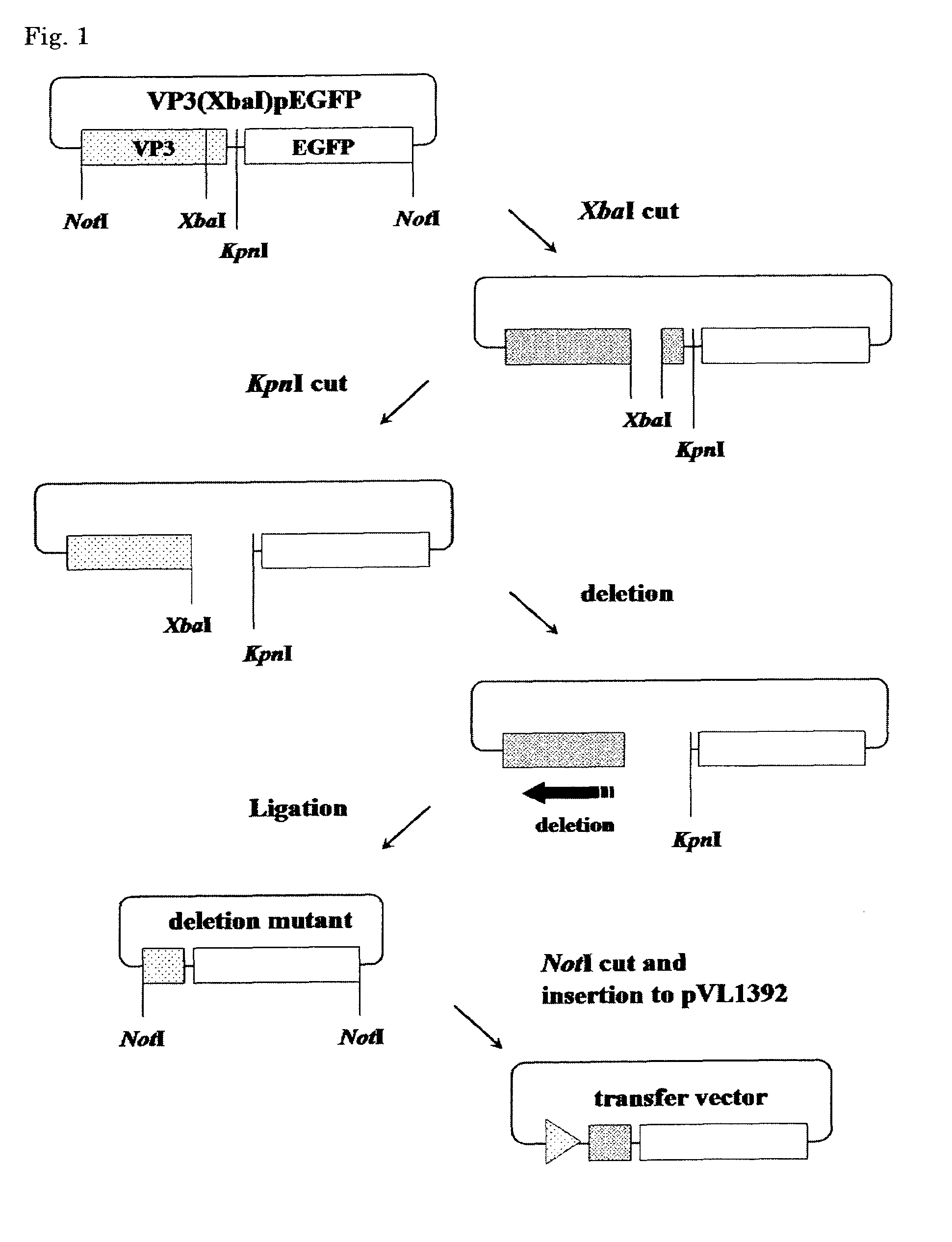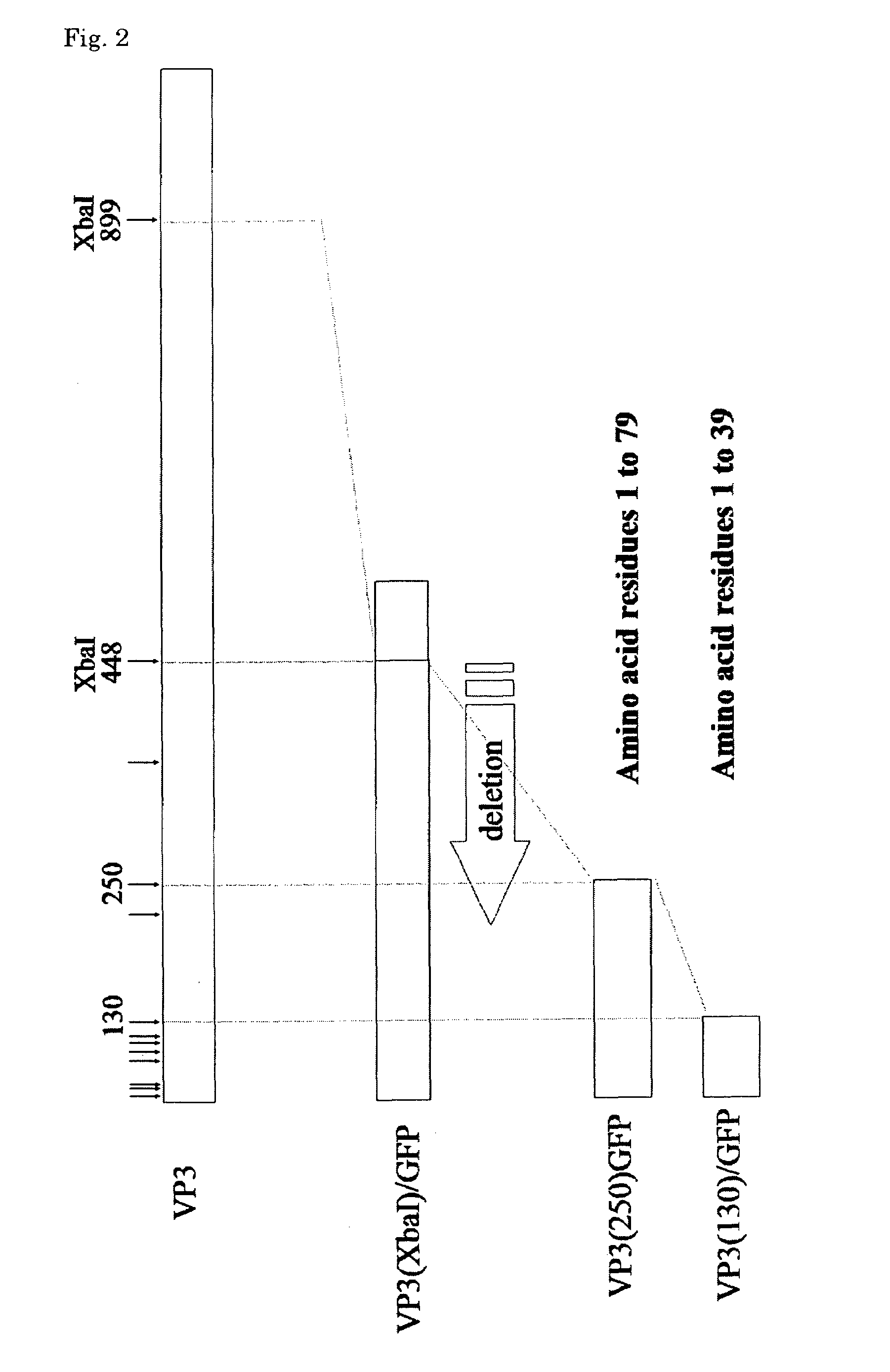Cytoplasmic polyhedrosis virus protein complex of a polyhedrin and a VP3 polypeptide
a polyhedrin and cytoplasmic polyhedrin technology, applied in the field of protein complexes, can solve the problems of inability to apply the method the binding site, the catalytic site or the like of the target protein cannot be controlled, and the method cannot be applied to all the target proteins. , to achieve the effect of sufficient function, increased color development of green fluorescence, and increased bioactivity of the target protein
- Summary
- Abstract
- Description
- Claims
- Application Information
AI Technical Summary
Benefits of technology
Problems solved by technology
Method used
Image
Examples
example 1
[0036]The present invention will be described according to Examples and the attached figures to explain it in more detail.
(1) Preparation of a Virus Producing a Polyhedral Protein
[0037]In the case where a polyhedron is produced with IPLB-Sf21-AE (Sf21) derived from an insect cell Spondoptera frugiperda, to form a cubic polyhedron of Bombyx mori cytoplasmic polyhedrosis virus (BmCPV), a recombinant virus (AcCP-H) that had been integrated with a polyhedral protein gene of BmCPV strain H (Mori et al., (1993) J. Gen. Virol. 74, 99-102) was inoculated. This AcCP-H is a recombinant virus that has been integrated with a polyhedral protein gene of strain H at the downstream of the polyhedrin promoter of a baculovirus vector derived from Autographa californica nucleopolyhedrovirus (AcNPV).
(2) Analysis of a Signal Composed of Only a Restricted Region of a Capsid Protein VP3
1) Shortening of BmCPV S4 Encoding a Capsid Protein VP3
[0038]A plasmid pVP3(XbaI)EGFP (International Patent Application W...
example 2
[0051]A biosensor was prepared by arranging a complex on a slide glass.
[0052]On a slide glass, 5 μl of a gelatin solution (gelatin: 0.5, Crk: 0.02) was dropped. Incidentally, Crk is chromium potassium sulfate (an antiseptic).
[0053]The front sides of the slide glass and a new slide glass were put together carefully. When the solution was spread therebetween, the slide glasses were slowly pulled apart. After the gelatin was completely dried, 1 μl of a complex solution which had been well stirred was dropped thereon, then dried, whereby a biosensor was prepared. This sensor was immersed in distilled water until use.
[0054]Incidentally, a complex solution represents a solution obtained by purifying a complex which has been expressed in a large amount in Sf21 cells, and suspending the purified complex in distilled water.
Verification
Verification method
(1) Suppression of Peroxidase Activity
[0055]A hydrogen peroxide solution (adjusted to a final concentration of 1% by PBS) was placed on the ...
PUM
| Property | Measurement | Unit |
|---|---|---|
| temperature | aaaaa | aaaaa |
| pH | aaaaa | aaaaa |
| concentration | aaaaa | aaaaa |
Abstract
Description
Claims
Application Information
 Login to View More
Login to View More - R&D
- Intellectual Property
- Life Sciences
- Materials
- Tech Scout
- Unparalleled Data Quality
- Higher Quality Content
- 60% Fewer Hallucinations
Browse by: Latest US Patents, China's latest patents, Technical Efficacy Thesaurus, Application Domain, Technology Topic, Popular Technical Reports.
© 2025 PatSnap. All rights reserved.Legal|Privacy policy|Modern Slavery Act Transparency Statement|Sitemap|About US| Contact US: help@patsnap.com



